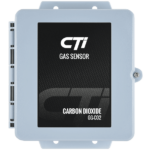Applications
CTI Ammonia Detectors are industrial strength and designed for:
Dry Ice Plants

Breweries

CO2 freeze hoods

Cold Storage

Indoor Air Quality
Chemical Plants
Regulatory Concentrations of Interest
There are several CO2 thresholds to consider
OSHA Permissible Exposure Limit (PEL):
-
-
-
- 5,000ppm TWA (8 hour time weighted average)
-
-
NIOSH (National Institute for Occupational Safety and Health) Recommended Exposure Limit:
-
-
-
- 5,000 ppm TWA
- 30,000 ppm STEL (Short Term Exposure Limit = 15 minute time weighted average)
- 40,000 ppm IDLH (Immediately Dangerous to Life and Health)
-
-
ACGIH (American Conference of Governmental Industrial Hygienists) TLV (Threshold Limit Value):
-
-
-
- 5,000 ppm TWA
- 30,000 ppm STEL
-
-
How to Buy A CO2 Detector
Codes and Specifications
CTI engineers have carefully studied the latest regulatory standards for the industrial use of CO2 and compiled the information into a helpful CO2 detection design guide. Download your free copy here.”
Alarm Levels and Recommended Outputs
See below table for CO2 detection alarm levels and outputs. For a thorough guide of codes and design specifications pertaining to Carbon Dioxide. see our “ABC’s of CO2” Guide.
| Use | Set Point | Action |
| As a refrigerant or in a process | 0.5% (5,000 ppm) | Investigate potential leak with hand-held CO2 leak detector
Initiate ventilation |
| As a refrigerant | 1.0% (10,000 ppm) | Shut down valves to evaporator
Activate audio visual alarms and evacuate the room. |
| In a process | 3.0% (30,000 ppm) | Activate audio visual alarms and evacuate the room. |

CTI Carbon Dioxide Detectors are built for harsh conditions and designed to prevent false alarms:
-
- Built-in, automatic heaters to withstand temperatures down to -50F.
-
- NDIR infrared sensor element with Carbon Dioxide specific technology.
-
- Sensor element ranges designed to accurately monitor OSHA’s TWA, PEL and STEL setpoints for personnel protection.
-
- Corrosion, weather, and chemical resistant NEMA 4X detectors offered in either polycarbonate or stainless steel enclosures.
Carbon Dioxide Detection for CO2 Cascade Systems
When Carbon Dioxide is used with Ammonia in a CO2 Cascade system, CO2 detectors are required in the compressor room as well as in the refrigerated and process areas. CO2 sensors should be located in the breathing zone near leak sources, such as compressors and evaporators. CO2 is always present in air, and concentrations can build up to alarm levels without a leak from the refrigeration system. If possible, in addition to accounting for leaks, locate sensors near high traffic areas to account for general CO2 build up. The 0-3% range is ideal for cascade systems, offering detection at the TWA (0.5%) and the STEL (3%).
Carbon Dioxide Detection for Bottling Plants
Bottling plants and other facilities using CO2 in a process should use a 0-3% range detector to initiate ventilation at the TWA(0.5%) and evacuate at the STEL(3.0%). Sensors should be placed at or below the breathing zone, near where operators work, and/or where people frequent for personnel protection. Sensors located at the source can cause inflated readings compared to what personnel are experiencing in their working environment. Sensors should only be located at the leak source if personnel are frequently present.
Carbon Dioxide Detection for Wineries
Wineries can have elevated CO2 levels during the fermentation process. Care should be taken to protect personnel from dangerous levels in these areas. A 0-1% sensor range is ideal for wineries to monitor the lower levels that are often found. The 0-1% range can closely monitor at and below the TWA, and up to 1% CO2 where ventilation can be activated to maintain a safe environment. Sensors should be located at or below the breathing zone, where personnel are most likely to be exposed.
Carbon Dioxide Sensor Elements
Carbon Dioxide sensor elements from CTI are offered with an infrared sensor element in different ranges and packages. The Infrared sensor elements boast long sensor life and carbon dioxide specific sensing technology. Rapid response times and long lasting accuracy make the infrared sensor element a great choice. Constant target gas exposure and background gases are not an issue for the infrared sensing element. Infrared sensors are only offered in higher ranges, which meshes well for CO2 detection at levels concerning personnel protection. Proper maintenance should take place to maintain the low end of the range, by calibrating the active zero with 500 ppm CO2 to maintain accuracy at everyday levels.






